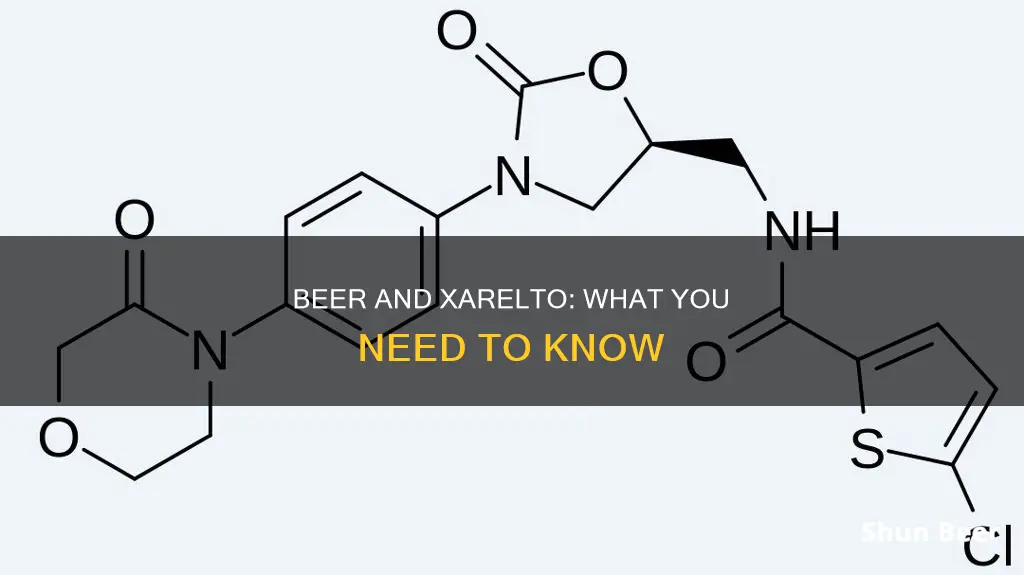
Xarelto is a blood-thinning medication that treats and prevents blood clots. It is used to treat conditions such as nonvalvular atrial fibrillation and deep vein thrombosis (DVT). While the official line from the manufacturer is that patients do not need to change their dietary habits, healthcare professionals generally advise against drinking alcohol while taking Xarelto. This is because both Xarelto and alcohol thin the blood, enhancing each other's effects and increasing the risk of minor to major bleeding problems.
| Characteristics | Values |
|---|---|
| Can you drink beer on Xarelto? | It is not recommended to drink alcohol while taking Xarelto. However, occasional drinking with Xarelto does not put you at significant risk. |
| Why is it not recommended? | Both Xarelto and alcohol are blood thinners, so when combined, they increase the risk of side effects, particularly minor to major bleeding problems. |
| What are the side effects? | Minor bleeding (nosebleeds, bruising, bleeding gums), major bleeding events (menstrual bleeding that is heavier than normal, coughing up blood, severe headaches), life-threatening internal bleeding |
| What amount of alcohol is considered safe with Xarelto? | According to The U.S. Dietary Guidelines for American adults, moderate drinking is up to one drink per day for women and up to two drinks per day for men. |
What You'll Learn
- Xarelto and alcohol both thin the blood
- Xarelto and alcohol are both broken down by the liver
- Excessive alcohol consumption can lead to severe bleeding problems when taking Xarelto
- Light to moderate drinking might be allowed under a doctor's guidance
- Xarelto and alcohol can cause similar side effects, including dizziness, fatigue, and stomach pain

Xarelto and alcohol both thin the blood
Xarelto is a blood thinner that treats and helps prevent blood clots. It works by blocking Factor Xa, an enzyme needed for blood clotting. This reduces the risk of deep vein thrombosis (DVT), pulmonary embolism (PE), and other similar conditions that could become fatal.
Alcohol, or ethanol, is also a blood thinner. It reduces the levels of fibrinogen, a protein needed for blood clotting. Research has shown that consuming two to three alcoholic drinks per day reduced fibrinogen levels in the blood by 14%.
Combining Xarelto and alcohol may lead to intensified anticoagulant activity in the blood. This can result in an increased risk of minor to major bleeding problems. Minor bleeding may include nosebleeds, bruising, and bleeding gums. More severe bleeding events, such as coughing up blood, heavier-than-normal menstrual bleeding, and severe headaches, are also possible. Internal bleeding is particularly dangerous as it is challenging to detect and can be life-threatening.
Additionally, both Xarelto and alcohol are processed by the liver. When alcohol is consumed, the liver may prioritise breaking it down over processing Xarelto, leading to excess amounts of Xarelto in the bloodstream and a higher risk of bleeding.
While occasional drinking with Xarelto may not pose a significant risk, healthcare professionals generally recommend against alcohol consumption while taking this medication. It is important for individuals taking Xarelto to consult with their doctor about their specific bleeding risks and receive guidance on alcohol intake.
Vaccine and Beer: What's Safe to Drink?
You may want to see also

Xarelto and alcohol are both broken down by the liver
Xarelto is a blood thinner that works by blocking Factor Xa, an enzyme needed for blood clotting. It is used to prevent and treat blood clots, which can lead to fatal conditions like strokes. While Xarelto is a convenient and simple drug, it is important to understand its potential side effects and interactions with other substances, especially alcohol.
Both Xarelto and alcohol are broken down by the liver. When consumed together, they compete for breakdown by the liver, which can lead to higher levels of Xarelto in the bloodstream, increasing the risk of bleeding. This is because both substances thin the blood, and their combined effect can lead to excessive thinning, resulting in minor to major bleeding problems.
Alcohol, or ethanol, is a component of beer, wine, and liquor. It acts as a blood thinner by reducing fibrinogen levels, a protein necessary for blood clotting. Research has shown that consuming two to three alcoholic drinks per day can decrease fibrinogen levels by 14%. When combined with Xarelto, this can intensify the blood-thinning effect, leading to an increased risk of bleeding.
The side effects of mixing Xarelto and alcohol include minor bleeding such as nosebleeds, bruising, and bleeding gums. More severe consequences can also occur, such as heavier-than-normal menstrual bleeding, coughing up blood, and severe headaches. The most dangerous form of bleeding is internal bleeding, as it is challenging to detect and can be life-threatening.
While occasional drinking with Xarelto may not pose a significant risk, excessive alcohol consumption (binge drinking) can result in extreme blood thinning. According to guidelines, moderate drinking is defined as up to one drink per day for women and up to two drinks per day for men. It is crucial to consult a doctor to understand your specific bleeding risks and receive guidance on alcohol consumption while taking Xarelto.
How Non-Alcoholic Beer Can Help Curb Alcohol Cravings
You may want to see also

Excessive alcohol consumption can lead to severe bleeding problems when taking Xarelto
Both Xarelto and alcohol thin the blood by affecting proteins involved in the blood clotting process. Alcohol, or ethanol, reduces fibrinogen levels, a protein necessary for blood clotting. Consuming two to three alcoholic drinks per day has been found to decrease fibrinogen levels by 14%. When combined with Xarelto, this can result in intensified anticoagulant activity in the blood, increasing the risk of bleeding problems.
Excessive alcohol consumption while taking Xarelto can lead to severe bleeding, including internal bleeding, which can be life-threatening. Additionally, alcohol can interfere with the liver's ability to process Xarelto, leading to excess amounts of the drug in the bloodstream and further increasing the risk of bleeding. Regular drinkers may need to monitor their blood levels or reduce their alcohol intake while taking Xarelto.
The combination of Xarelto and alcohol can also exacerbate side effects such as dizziness, fatigue, and stomach pain. In rare cases, it may also contribute to insomnia, anxiety, and depression. Therefore, it is generally advised to avoid alcohol while taking Xarelto. However, light to moderate drinking may be permissible under a doctor's guidance. It is crucial to consult a healthcare professional to understand the specific bleeding risks and make informed decisions about alcohol consumption while taking Xarelto.
Beer and Anemia: Is There a Link?
You may want to see also

Light to moderate drinking might be allowed under a doctor's guidance
While it is generally advised to avoid alcohol while taking Xarelto, light to moderate drinking might be allowed under a doctor's guidance. Xarelto is a prescription blood thinner used to treat and prevent blood clots, specifically by blocking factor Xa, a vital protein involved in the formation of blood clots. Similarly, alcohol is a substance that can also affect the blood clotting process by reducing fibrinogen levels, another protein involved in blood clotting.
When taken together, Xarelto and alcohol can cause dangerous bleeding problems due to their combined effects on blood thinning. However, light to moderate drinking with Xarelto may not put you at significant risk. According to the U.S. Dietary Guidelines for American adults, moderate drinking is defined as up to one drink per day for women and up to two drinks per day for men. Occasional drinking with Xarelto is generally considered safe and does not appear to interfere with the drug's mechanism of action.
It is important to note that excessive alcohol consumption while taking Xarelto can lead to severe bleeding problems and may worsen side effects such as insomnia, anxiety, and depression, as well as cause liver damage. Therefore, it is crucial to consult a doctor to understand your specific bleeding risks and receive guidance on safe alcohol consumption, especially if you have chronic medical problems associated with your liver or kidneys.
Beer and Painkillers: Safe Mix or Not?
You may want to see also

Xarelto and alcohol can cause similar side effects, including dizziness, fatigue, and stomach pain
Xarelto, a prescription blood thinner, is designed to prevent clotting in the blood that could lead to a stroke or other fatal conditions. It is important to note that Xarelto and alcohol can cause similar side effects, including dizziness, fatigue, and stomach pain.
Xarelto works by blocking Factor Xa, an enzyme needed for blood clotting. This action helps to prevent and treat blood clots, reducing the risk of deep vein thrombosis (DVT) and pulmonary embolism (PE). However, one of the most severe side effects of Xarelto is bleeding. When combined with alcohol, the risk of bleeding increases significantly.
Alcohol, or ethanol, is a substance found in beer, wine, and liquor. It acts as a blood thinner by reducing fibrinogen levels, another protein involved in blood clotting. Consuming two to three alcoholic drinks per day can decrease fibrinogen levels by 14%. Therefore, mixing Xarelto with alcohol can intensify the blood-thinning effect, leading to potential bleeding problems.
Minor bleeding incidents may include nosebleeds, bruising, and prolonged bleeding from cuts or wounds. More severe bleeding events, such as coughing up blood, heavy menstrual bleeding, and severe headaches, can also occur. Internal bleeding is particularly dangerous as it is challenging to detect and can be life-threatening.
Both Xarelto and alcohol are processed by the liver. When consumed together, the liver may prioritise breaking down alcohol over processing the blood-thinning medication. This can result in higher levels of Xarelto in the bloodstream, further elevating the risk of bleeding.
Additionally, alcohol consumption can worsen the side effects of Xarelto, including dizziness, fatigue, and stomach pain. In rare cases, Xarelto has been associated with insomnia, anxiety, and depression, which are also linked to alcohol use. Chronic alcohol consumption can increase the risk of alcohol use disorder, often accompanied by anxiety and depressive disorders.
To summarise, while occasional drinking with Xarelto may not pose a significant risk, the combination of Xarelto and alcohol can lead to enhanced blood-thinning effects and an increased risk of bleeding. It is crucial to consult a healthcare professional for personalised advice and to understand your specific bleeding risks.
Beer and Rudraksha: A Spiritual Conundrum?
You may want to see also







